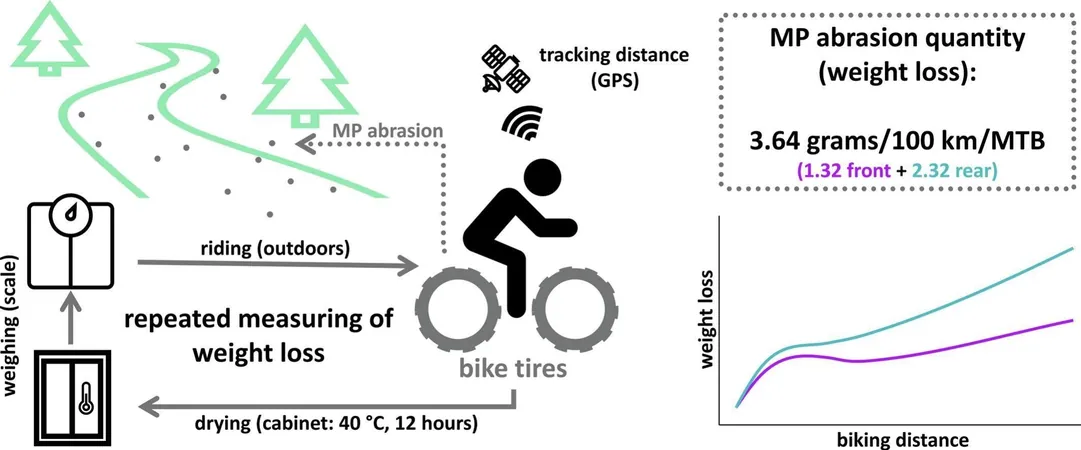
Shocking Discovery: Microplastic Emissions from Mountain Biking Revealed!
2025-04-03
Author: Li
Groundbreaking Study on Microplastic Emissions
In a groundbreaking study by researchers at the University of Bayreuth, new data sheds light on the microplastic emissions generated from mountain biking. Published in the esteemed journal *Science of The Total Environment*, this research marks the first time concrete figures have been presented regarding tire wear in off-road cycling conditions, offering critical insights into the global microplastic cycle.
The Impact of Microplastics
Microplastics have infiltrated every corner of our environment—be it in household products, food sources, and even within our own bodies. The ramifications of this pollution on ecosystems and health are alarming, as microplastics are known to disrupt the balance of natural habitats and potentially harm human health. Historically, motor vehicles have been recognized as a significant contributor to microplastic contamination, primarily through tire wear, which releases about 11 grams of microplastics per 100 kilometers driven. This accounts for a staggering 57% of microplastic pollution from road traffic and approximately 35% of total pollution figures in Germany alone.
Unquantified Impact of Mountain Biking
However, the environmental impact of cycling, particularly mountain biking—a growing recreational activity that now engages about 20% of Germany's population—has largely remained unquantified. Addressing this gap, the University of Bayreuth’s research team embarked on a study to assess the tire abrasion produced by mountain biking, especially in the serene and pristine landscapes where this hobby often takes place.
Methodology of the Study
To conduct the study, a dedicated team led by doctoral researcher Fabian Sommer equipped nine passionate mountain bikers with brand-new tires. The bikers followed their typical routes, tracked via GPS, while periodic lab weigh-ins measured any material loss due to tire abrasion. The results revealed that on average, mountain biking generates approximately 3.5 grams of microplastic waste for every 100 kilometers ridden, translating to a yearly per-person contribution of up to 88 grams. Alarmingly, when contextualized with Germany’s overall microplastic pollution, mountain biking contributes to less than 1%.
Key Findings and Insights
Interestingly, the study also indicated that the initial phase of tire usage saw a greater rate of abrasion—higher during the first 500 kilometers—likely due to the gradual rounding of edges and the removal of manufacturing remnants, including fine, hair-like structures integral to new tire designs.
“The findings from our study provide the first reliable data concerning tire wear from mountain bikes in real-world conditions,” remarks Sommer. “While our research confirms that mountain bike tires do release microplastics into nature, the volume is markedly lower when compared to their motorized counterparts. This further emphasizes cycling’s sustainability as an eco-friendly mode of transportation.”
Future Research Directions
Looking ahead, researchers plan to broaden their study with a follow-up investigation examining tire wear across various types of bicycles, including road bikes, gravel bikes, and e-mountain bikes. This will further enhance our understanding of microplastic dynamics in different cycling formats and valuable insights into ways to reduce environmental impact.
Call to Action
Join the movement to keep our trails clean and promote the awareness of microplastic pollution! Your journey begins with informed choices. Are you ready to make a difference?



 Brasil (PT)
Brasil (PT)
 Canada (EN)
Canada (EN)
 Chile (ES)
Chile (ES)
 Česko (CS)
Česko (CS)
 대한민국 (KO)
대한민국 (KO)
 España (ES)
España (ES)
 France (FR)
France (FR)
 Hong Kong (EN)
Hong Kong (EN)
 Italia (IT)
Italia (IT)
 日本 (JA)
日本 (JA)
 Magyarország (HU)
Magyarország (HU)
 Norge (NO)
Norge (NO)
 Polska (PL)
Polska (PL)
 Schweiz (DE)
Schweiz (DE)
 Singapore (EN)
Singapore (EN)
 Sverige (SV)
Sverige (SV)
 Suomi (FI)
Suomi (FI)
 Türkiye (TR)
Türkiye (TR)
 الإمارات العربية المتحدة (AR)
الإمارات العربية المتحدة (AR)